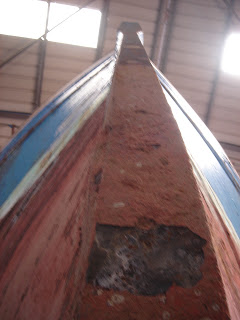The new tanks hold 800 gallons each which, with the improved fuel efficiency of the new engine will give us about 1/2 gallon per mile, if we don't go much above 5 knots, wind-behind and downhill, that's a range of about 3200 miles, ish.
Not that we are planning to cross the Atlantic; can't say I there are enough years left in the century to do justice to all of the richness of European and Byzantine history and the peoples of the Mediterranean so we're heading East, when we leave British and Irish waters.

The back of these tanks is cunning designed to fit closely in the curve of the ribs, so allowing maximum tankage for space. There are also lovely little "pots" made into the shape, visible at the bottom of each tank in the middle of this picture, this will mean we can draw off any water that might have condensed and any grollies that might have grown in the oil/water layer that might form.
The roof of the wheelhouse is massive, and we immediately started worrying about whether the whole superstructure was too tall, not for safety, it's all aluminium so very light, but from an aesthetic point of view.

When buying a house it is important that one likes the looks of it from the outside, much like a husband or wife, they've got to have kerb-appeal, and while not all of us can merit a Nicole Kidman look-alike (apart from the skipper, of course) there has to be a certain fondness for a face, and similarly we hope to have a boat whose looks we like.
So, we have spend a great deal of time poring over the pictures from the naval architect and have decided that the design is fine, any lumpiness made up for for kindly accommodation and ease of living (much like the compromises one makes in choosing a mate, you might say)

As can be seen from this drawing, there is ample space for four marketing executives to occupy the wheel-house and the deck-house. As usual, the PR specialist on the bridge is not paying attention to the course but is staring out over the starboard bow and is shouting"I am on the boat!"
This outline is a pretty good indication of how much space we are going to have. The arrangement of various living areas is so flexible, with a 14ft by 23ft space in the deckhouse alone that there are almost too many choices to make chooses.

Also, I wonder, if one builds a large galley, does that automatically mean that one will spend most of one's time there? I believe the skipper has a voice tube to install from the bridge to the "bacon sandwich station" so he can order up various tasty morsels. The crew might find another, more entertaining, use for the whistle in the end of the tube, if this instrument comes to be used to exploit the crew.
One of the things we have learned along the way from reading endless expensive motor-boat magazines and, more usefully, talking to people who have done it, the advice is to get side doors to help ventillation in the Mediterranean. We have also arrange twin french windows at the back of the deck-house to give a more open-plan feel. These are features of which we are very proud, and were delighted to find that we could fit in a deck-level cabin, which will be where we live when we first move onboard.
At the front of the deckhouse is a wooden seat, which will be just lovely for sitting on while the boat goes along, the best place for anyone with a gippy stomach and for the crew to rest away from the shriek of the voice-tube.

 Another thing that needs attention is the stern post; this damage might be gribble, but we don't know, we'll see what the boat-builders can find out. There is so much wood here that even with this wear we are not concerned about Heroine's strength.
Another thing that needs attention is the stern post; this damage might be gribble, but we don't know, we'll see what the boat-builders can find out. There is so much wood here that even with this wear we are not concerned about Heroine's strength. 
 The Easter visit was just in time to see the new fuel tanks and the flat panels for the wheel-house and deckhouse standing up and taking shape.
The Easter visit was just in time to see the new fuel tanks and the flat panels for the wheel-house and deckhouse standing up and taking shape.




